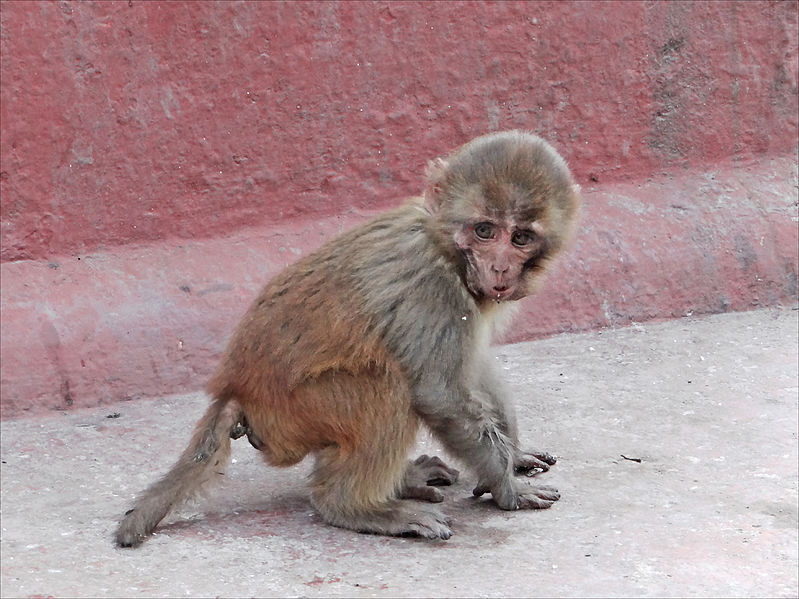
Life Cycle
The Macaca mulatta developed from its genus Macaca. They
are from the family cercopithecidae and are all primates.
(PlanetWildLife.com) The Rhesus monkey’s and all primates have
evolved from the mammalian way of reproduction that evolved over a
long period of time.
The Rhesus monkey reproduces by sexual reproduction (Timmins 2008).
A male fertilizes a females eggs with his sperm. The sexual
reproduction life cycle produced by Rhesus monkeys is gametic. The
gametic life cycle starts off with a male diploid and a female
diploid. They go through the process of meiosis to produce gametes.
These haploid gametes are then facilitated next to each other and
begin plasmogamy. This is when the cell walls of the two cells fuse
together. After the walls have been fused then the cell’s nuclei
fuse together into one cell which is called karyogamy. Plasmogamy
and karyogamy are the two steps of the fertilization process. Once
the egg has been fertilized then it is a diploid zygote. It has
genes
from both the mother and father chromosomes. The zygote then
goes
through mitosis to reproduce the cells chromosomes and form a
new adult Rhesus monkey, which is similar but not the same as the
parents.
This process is beneficial to the Rhesus monkeys and is an
influential factor in their survival. The process of sexual
reproduction provides an escape from disease, predation, starvation,
etc. It does this in two ways, mutation and by the mixing of genes.
The mutations are only random errors in the gene sequencing that can
be both good and bad. The changes in genes may cause one of the
monkeys to not have any teeth. This would prevent the monkey from
eating all of the hard foods that compose its diet such as seeds and
nuts. A good mutation could be larger front fangs to ward off
potential competition for mates. The main reason for sexual
reproduction is the mixing of genes. Two adults, one male and one
female, mix their genes together and this produces an even higher
amount of change in the genes. This causes a greater chance in
adaption to a changing environment. This is essential for all of the
different environments that the Rhesus monkey lives in. The many
environments has this monkey needing the many changes in genes to
avoid different diseases from the nuanced areas that they come in
contact with as well as numerous other organisms.
 Another
advantage for the survival of Rhesus monkeys as a population in
their environment is that they are mammals. Mammals are born as
immature rhesus monkeys. These infants can move and have most of the
features of the adult Rhesus monkeys such as the limbs for climbing
and walking. These characteristics of mammalian organisms have
advantages over organisms that lay eggs or larvae. These traits are
things like motility and self defense. The Rhesus monkey in
particular uses its motility to hang onto its parents while they
climb to obstacles or trees. This gives the babies protection from
predators. Also, the baby Rhesus monkeys can move around and away
from predators. Plus, a baby Rhesus monkey can forage
for
grapes,
mangos,
apples,
peanuts, etc. This gives the
baby
the ability to feed itself. Another thing that
benefits this monkey’s survival is that the entire time that it is a
baby, growing, feeding itself, it is watching its environment and
learning. They learn how to hunt and the societal norms of their
culture. What they are to do and not to do in their hierarchical
position (Lang 2005).
Another
advantage for the survival of Rhesus monkeys as a population in
their environment is that they are mammals. Mammals are born as
immature rhesus monkeys. These infants can move and have most of the
features of the adult Rhesus monkeys such as the limbs for climbing
and walking. These characteristics of mammalian organisms have
advantages over organisms that lay eggs or larvae. These traits are
things like motility and self defense. The Rhesus monkey in
particular uses its motility to hang onto its parents while they
climb to obstacles or trees. This gives the babies protection from
predators. Also, the baby Rhesus monkeys can move around and away
from predators. Plus, a baby Rhesus monkey can forage
for
grapes,
mangos,
apples,
peanuts, etc. This gives the
baby
the ability to feed itself. Another thing that
benefits this monkey’s survival is that the entire time that it is a
baby, growing, feeding itself, it is watching its environment and
learning. They learn how to hunt and the societal norms of their
culture. What they are to do and not to do in their hierarchical
position (Lang 2005).
The Macaca Mulatta has developed and
survived with sexual reproduction of the gametic life cycle. It uses
the traits from this cycle to adapt to its environment and therefore
have a better chance of surviving as a population. The monkey being
a mammal has benefited its survival, and the endurance of the
species in general. The life history of the reproduction is a list
of the many different adaptations that the Rhesus monkey has evolved
to change its genes in order to adapt to its environments.
Return home or learn more about the morphology of the Rhesus monkey.